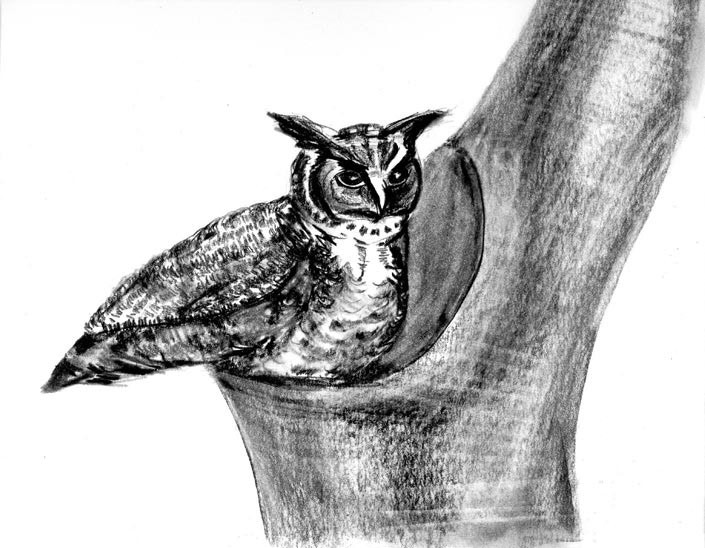
For many, the greatest joy of spring is the return of migratory birds and the chance to observe—from a polite distance, of course—their busy rituals of courtship, nesting, and tending newly hatched offspring. In early March, that return still seems very far away. All around us, though, in woods, orchards, parks, and old farm buildings, a few of our over-wintering birds are now sitting on eggs in the nest. One of the most dramatic and mysterious of these birds, the great horned owl (Bubo virginianus), is also the first species in New England to nest.
In our region, the great horned owl—named for the prominent feather tufts on its head—begins courting in early February, when males and females sing to one another and males demonstrate their prowess in display flight. After mating, the owls find the abandoned nest of another bird to use. At 18 to 25 inches in height and with a wingspan of more than four feet, great horned owls need plenty of room, and they commonly take over an old hawk, crow, or heron nest. They also nest in large tree cavities or along cliff ledges, choosing a secluded and protected site 30 to 70 feet above the ground. The female usually lays two to three eggs. She is primarily responsible for incubating them, but the male will bring her food and sit on the nest for short periods.
Inside the egg, the owl chick develops for 30 to 35 days. At hatching time, around mid-March, the chick begins to peck with its “egg tooth,” a pointy bump on top of the beak, until it has perforated the shell all the way around, and then pushes its way out. This is a mighty effort for the tiny chick, which weighs less than an ounce, and can take as long as three days. Once out of the shell, chicks will rest for several hours before they are able to feed. Emerging from their eggs looking pink and naked, owl chicks quickly grow a covering of fluffy down that keeps them warm. With chicks in the nest, both parents share in care and feeding, one staying nearby to stand guard while the other searches for food. They are fiercely protective parents and will drive away other creatures venturing too close to the nest.
Great horned owls are birds of prey, or raptors, that feed most commonly on rabbits and mice, but also on snakes and other birds, including chickens. Described as “perch-and-pounce” hunters, they generally hunt at night, but when feeding chicks will go out at dawn and dusk. Like other owls, great horned owls are extremely well-adapted to night hunting. With feathers covered in a fine down that makes flight nearly silent, dish-shaped faces that funnel light and sound into unusually large eyes and ears, and powerful beaks and feet, owls can easily discover and overcome unsuspecting prey. Returning to the nest, parents tear meat apart to feed to their chicks.
Though owls grow more slowly than other raptors, an owl chick at two weeks is already able to swallow a whole mouse. All owls eat their prey whole or in large pieces, swallowing bones, fur, feathers, and other indigestible body parts. Their stomachs cope by sorting these parts out and making them into a furry pellet that owls cough up about once a day. In great horned owls, these pellets can be up to five inches long.
Great horned owl chicks stay in the nest for six to seven weeks and then begin exploring nearby branches. They continue to be fed by their parents until they are about 10 weeks old and begin to fly. Young owls will stay with their parents for up to several months, learning the hunting skills they need to survive the next winter. When they are two years old, these owls will begin to look for a mate.
Great horned owls are widespread in New Hampshire and Vermont, but because of their nocturnal habits and their tendency to avoid people, they are not commonly seen. A careful observer might spot one during the day by looking high up in the trees in a densely wooded area. This bird is an excellent camouflage artist, though. In New England, their plumage is brown and buff with black barring, so they blend into the tree trunks. Their prominent, widely spaced ear tufts distinguish them from their more common cousin, the barred owl.
Most of us have heard the calls of great horned owls at night, a “resonant hooting” as Roger Tory Peterson describes them. The male will repeat Hoo, hoo-oo, hoo, hoo four to five times, while the female’s call is Hoo,hoo-hoo-hoo, hoo-oo, hoo-oo repeated six to eight times. When we hear their back and forth hooting in late January or early February, we know that spring is inching north.

